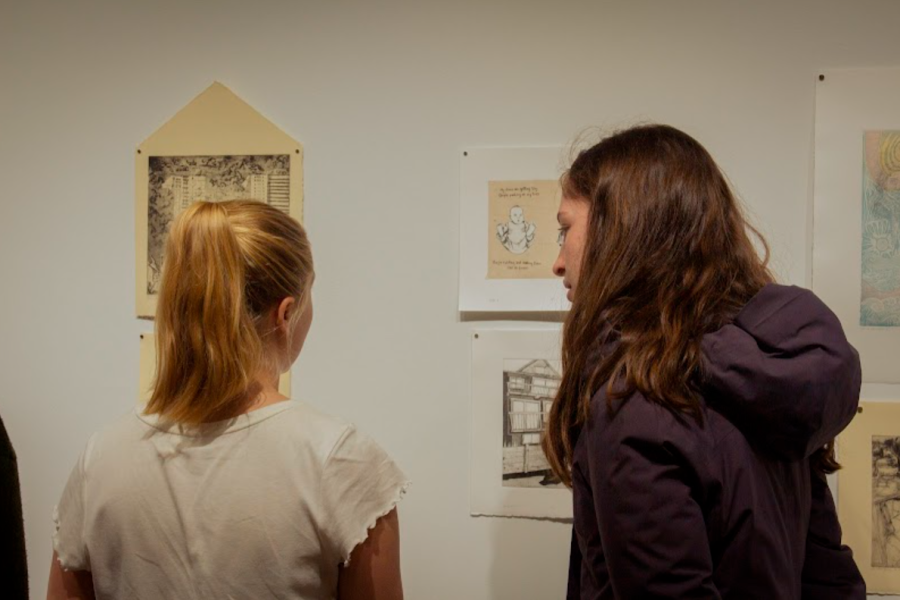On April 5, students who went on the Studio Art in the South Pacific OCS trip held a reception and art show. The gallery show, held in Boliou Hall, displayed a collection amassed from the compositions the study-abroad students created during their program.
As stated in the off-campus studies website, the program “provides a rare focus to studio work.” Additionally, it seeks students’ improvement in drawing and printmaking as a “way to better appreciate their surroundings. [Students] will also examine social and environmental issues, study indigenous cultures and learn to be thoughtful travelers.”
The program mostly traveled through Australia, visiting various locations within the country, including Melbourne, Queensland, Lady Elliot Island, Brisbane, Tasmania and others.
The course of study included four classes, three of which were in studio arts. One of them, a media drawing class, included constantly drawing the surrounding environment.
“[The media drawing class] required us to fill up two to three sketchbooks with drawings that captured our surroundings and landscape,” said Tonushree Chowdhury ’24. “These drawings could be quick gestural ones or longer watercolor paintings of the scenery or people around us.”
Another class was in printmaking, instructing students in “all the processes of intaglio and relief printmaking.” The class took place mostly in the three weeks in Melbourne, with intensive 9 a.m. to 5 p.m. days.
“It’s an intense and productive period of time. Students learn about the printmaking process, hone their technical skills, work collaboratively in a studio and consider the narrative quality in their work,” said Program Director and Studio Art Visiting Assistant Professor Eleanor Jensen ’01.
Despite the intensity of the workshop, some travelers enjoyed the opportunity to learn a new discipline.
“Printmaking was new to me as well as most other students on the trip. It brought me a new sense of engagement on the trip,” said Riaz Kelly ’24. “We were tasked with drawing almost exclusively from life. So having more control over creative decisions and abstraction was exciting in the printmaking course.”
However, most of the program was not spent in the studio.
“We stayed at a variety of places, mostly remote, for two to five days at a time. At these places, we had many discussions with Aboriginal elders about their culture and sad colonial history,” Kelly said. “We stayed at some of the most beautiful places I’ve ever been and had countless opportunities to hike where we wanted to and draw for hours.”
The pedagogical style of the program is illustrative of Jensen’s vision, where experiential learning takes priority.
“One very important component of the program is that much of the learning is experiential. This type of educational environment offers students a unique way to see and relate to their surroundings. And the focus of artistic study differs a lot from the campus structure and pace,” Jensen said. “The time spent in near-daily drawing exercises and concentrated printmaking sessions produces better attentiveness, quick technical improvement and a consistent output of artwork.”
Despite now being led by Jensen, the program was previously led by Professor of Art Emeritus Fred Hagstrom starting in the late 90s. Jensen, a Carleton alumni, went on it as a student, then went as an assistant multiple times and now leads it herself.
“Fred is a really important mentor of mine. He retired recently, and this is a unique program that I’m very passionate about continuing. I benefited immensely from its deep history and longstanding relationships, and I’m also part of an ongoing effort to strengthen it every time it runs,” said Jensen.
As it is customary for the program, students submitted work to be displayed as proof of their improvements.
“This program typically displays artwork on campus after the completion of the program, either in Boliou or Weitz,” said Jensen. “That’s a beautiful component of making art — there is the physical proof of time and effort. Sharing that with people on campus helps acknowledge the goals of the program and the community involved in it.”
For students like Kelly, deciding what to include in the show was a simple decision.
“It was pretty easy for me to decide what work to put in the show at Boliou. I felt like I grew a lot as an artist and as a result, I was much happier with my artwork towards the end of the trip,” said Kelly.
Jensen played a key role in deciding the work that would be displayed. The director chose two works per student, and students chose which page of their sketchbook would make it on the show.
“I am so proud of their work and their consistent commitment to making work throughout the term,” said Jensen. “The Boliou show is an opportunity to see it from a different perspective, to step back and reflect. I also know the behind-the-scenes details that went into the creation process of the prints and drawings, which adds layers to how I see the final product.”












